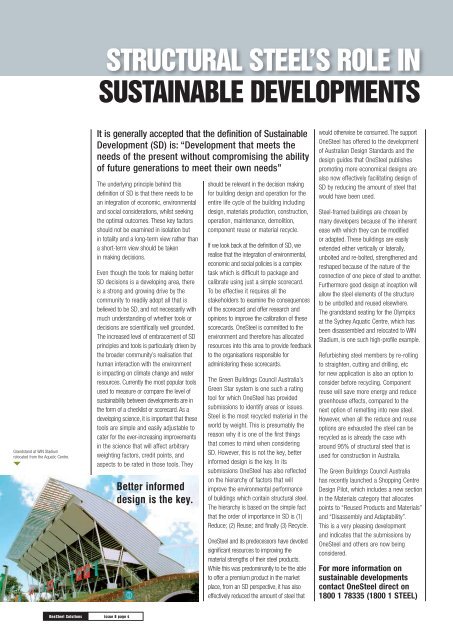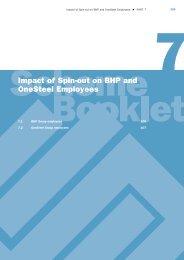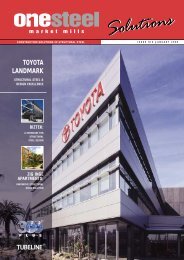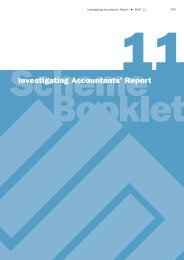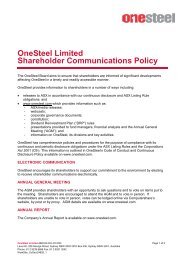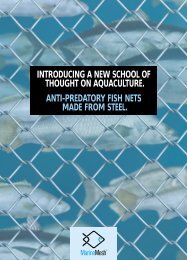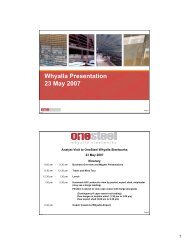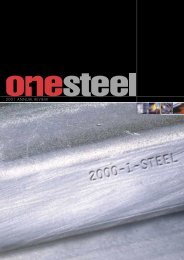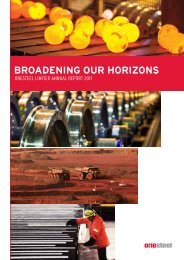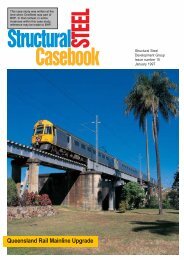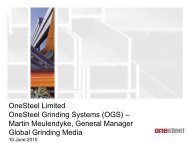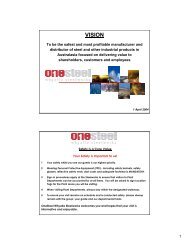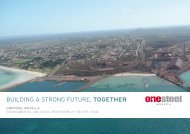STEEL FRAME CONSTRUCTION: DRIVEN BY STEEL: - OneSteel
STEEL FRAME CONSTRUCTION: DRIVEN BY STEEL: - OneSteel
STEEL FRAME CONSTRUCTION: DRIVEN BY STEEL: - OneSteel
Create successful ePaper yourself
Turn your PDF publications into a flip-book with our unique Google optimized e-Paper software.
Structural Steel’s Role in<br />
SUSTAINABLE DEVELOPMENTS<br />
Grandstand at WIN Stadium<br />
relocated from the Aquatic Centre.<br />
It is generally accepted that the definition of Sustainable<br />
Development (SD) is: “Development that meets the<br />
needs of the present without compromising the ability<br />
of future generations to meet their own needs”<br />
The underlying principle behind this<br />
definition of SD is that there needs to be<br />
an integration of economic, environmental<br />
and social considerations, whilst seeking<br />
the optimal outcomes. These key factors<br />
should not be examined in isolation but<br />
in totality and a long-term view rather than<br />
a short-term view should be taken<br />
in making decisions.<br />
Even though the tools for making better<br />
SD decisions is a developing area, there<br />
is a strong and growing drive by the<br />
community to readily adopt all that is<br />
believed to be SD, and not necessarily with<br />
much understanding of whether tools or<br />
decisions are scientifically well grounded.<br />
The increased level of embracement of SD<br />
principles and tools is particularly driven by<br />
the broader community’s realisation that<br />
human interaction with the environment<br />
is impacting on climate change and water<br />
resources. Currently the most popular tools<br />
used to measure or compare the level of<br />
sustainability between developments are in<br />
the form of a checklist or scorecard. As a<br />
developing science, it is important that these<br />
tools are simple and easily adjustable to<br />
cater for the ever-increasing improvements<br />
in the science that will affect arbitrary<br />
weighting factors, credit points, and<br />
aspects to be rated in those tools. They<br />
Better informed<br />
design is the key.<br />
should be relevant in the decision making<br />
for building design and operation for the<br />
entire life cycle of the building including<br />
design, materials production, construction,<br />
operation, maintenance, demolition,<br />
component reuse or material recycle.<br />
If we look back at the definition of SD, we<br />
realise that the integration of environmental,<br />
economic and social policies is a complex<br />
task which is difficult to package and<br />
calibrate using just a simple scorecard.<br />
To be effective it requires all the<br />
stakeholders to examine the consequences<br />
of the scorecard and offer research and<br />
opinions to improve the calibration of these<br />
scorecards. <strong>OneSteel</strong> is committed to the<br />
environment and therefore has allocated<br />
resources into this area to provide feedback<br />
to the organisations responsible for<br />
administering these scorecards.<br />
The Green Buildings Council Australia’s<br />
Green Star system is one such a rating<br />
tool for which <strong>OneSteel</strong> has provided<br />
submissions to identify areas or issues.<br />
Steel is the most recycled material in the<br />
world by weight. This is presumably the<br />
reason why it is one of the first things<br />
that comes to mind when considering<br />
SD. However, this is not the key, better<br />
informed design is the key. In its<br />
submissions <strong>OneSteel</strong> has also reflected<br />
on the hierarchy of factors that will<br />
improve the environmental performance<br />
of buildings which contain structural steel.<br />
The hierarchy is based on the simple fact<br />
that the order of importance in SD is (1)<br />
Reduce; (2) Reuse; and finally (3) Recycle.<br />
<strong>OneSteel</strong> and its predecessors have devoted<br />
significant resources to improving the<br />
material strengths of their steel products.<br />
While this was predominantly to be the able<br />
to offer a premium product in the market<br />
place, from an SD perspective, it has also<br />
effectively reduced the amount of steel that<br />
would otherwise be consumed. The support<br />
<strong>OneSteel</strong> has offered to the development<br />
of Australian Design Standards and the<br />
design guides that <strong>OneSteel</strong> publishes<br />
promoting more economical designs are<br />
also now effectively facilitating design of<br />
SD by reducing the amount of steel that<br />
would have been used.<br />
Steel-framed buildings are chosen by<br />
many developers because of the inherent<br />
ease with which they can be modified<br />
or adapted. These buildings are easily<br />
extended either vertically or laterally,<br />
unbolted and re-bolted, strengthened and<br />
reshaped because of the nature of the<br />
connection of one piece of steel to another.<br />
Furthermore good design at inception will<br />
allow the steel elements of the structure<br />
to be unbolted and reused elsewhere.<br />
The grandstand seating for the Olympics<br />
at the Sydney Aquatic Centre, which has<br />
been disassembled and relocated to WIN<br />
Stadium, is one such high-profile example.<br />
Refurbishing steel members by re-rolling<br />
to straighten, cutting and drilling, etc<br />
for new application is also an option to<br />
consider before recycling. Component<br />
reuse will save more energy and reduce<br />
greenhouse effects, compared to the<br />
next option of remelting into new steel.<br />
However, when all the reduce and reuse<br />
options are exhausted the steel can be<br />
recycled as is already the case with<br />
around 95% of structural steel that is<br />
used for construction in Australia.<br />
The Green Buildings Council Australia<br />
has recently launched a Shopping Centre<br />
Design Pilot, which includes a new section<br />
in the Materials category that allocates<br />
points to “Reused Products and Materials”<br />
and “Disassembly and Adaptability”.<br />
This is a very pleasing development<br />
and indicates that the submissions by<br />
<strong>OneSteel</strong> and others are now being<br />
considered.<br />
For more information on<br />
sustainable developments<br />
contact <strong>OneSteel</strong> direct on<br />
1800 1 78335 (1800 1 <strong>STEEL</strong>)<br />
<strong>OneSteel</strong> Solutions<br />
issue 8 page


